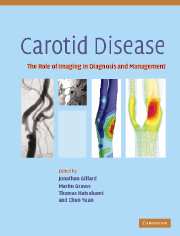Book contents
- Frontmatter
- Contents
- List of contributors
- List of abbreviations
- Introduction
- Background
- Luminal imaging techniques
- Morphological plaque imaging
- 14 MR plaque imaging
- 15 CT plaque imaging
- 16 Assessment of carotid plaque with conventional ultrasound
- 17 Assessment of carotid plaque with intravascular ultrasound
- 18 Image postprocessing
- Functional plaque imaging
- Plaque modelling
- Monitoring the local and distal effects of carotid interventions
- Monitoring pharmaceutical interventions
- Future directions in carotid plaque imaging
- Index
- References
14 - MR plaque imaging
from Morphological plaque imaging
Published online by Cambridge University Press: 03 December 2009
- Frontmatter
- Contents
- List of contributors
- List of abbreviations
- Introduction
- Background
- Luminal imaging techniques
- Morphological plaque imaging
- 14 MR plaque imaging
- 15 CT plaque imaging
- 16 Assessment of carotid plaque with conventional ultrasound
- 17 Assessment of carotid plaque with intravascular ultrasound
- 18 Image postprocessing
- Functional plaque imaging
- Plaque modelling
- Monitoring the local and distal effects of carotid interventions
- Monitoring pharmaceutical interventions
- Future directions in carotid plaque imaging
- Index
- References
Summary
Introduction
The progression of atherosclerosis, from its initial state to the formation of “high risk” advanced lesions, is in most cases a complex, indolent process. Noninvasive techniques for imaging the diseased vessel wall will play an increasingly important role in the assessment of atherosclerotic disease status, so that optimized treatment schemes, from lifestyle changes to surgery or stenting, can be individualized for each patient.
In this chapter, the state-of-the-art noninvasive magnetic resonance imaging (MRI) techniques used to monitor atherosclerosis of the carotid artery are introduced and summarized. The clinical value of these techniques will be assessed and the future role of MR in vascular imaging will be considered.
Role of MRI
Clinically, the degree of lumen stenosis is used as a marker for atherosclerosis severity. Vulnerable plaques, however, often elude detection by techniques that rely on measuring the size of the vessel lumen alone. One reason this occurs is due to expansive arterial remodeling, in which the artery increases only its external wall boundary in response to the development of an atherosclerotic plaque (Glagov et al., 1997). The other reason is that plaque tissue constituents are closely linked to not only lumen size but also plaque vulnerability (Fuster et al., 2005). Thus, an ideal imaging technique should be able to demarcate the vessel lumen and outer wall boundary, distinguish the main atherosclerotic plaque components, and determine luminal surface conditions.
- Type
- Chapter
- Information
- Carotid DiseaseThe Role of Imaging in Diagnosis and Management, pp. 180 - 190Publisher: Cambridge University PressPrint publication year: 2006



